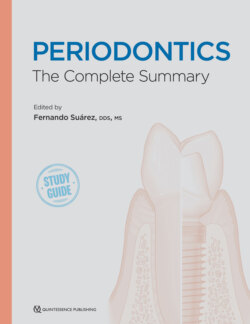Читать книгу Periodontics - Fernando Suarez - Страница 20
На сайте Литреса книга снята с продажи.
Junctional epithelium
ОглавлениеThe junctional epithelium extends apically from the base of the gingival sulcus following the tooth structure, and it is a nondifferentiated stratified squamous epithelium.23 In healthy situations with no history of periodontal disease or gingival deformities, the deepest portion of the junctional epithelium is located around the CEJ. It has a triangular shape with the base at the bottom of the sulcus and a vertex located apically. The base of the junctional epithelium has a layer 20 to 30 cells thick, which decreases in number to become a bilayer at the level of the CEJ.24 The junctional epithelium is attached to the tooth surface through hemidesmosomes, while the connections in between the epithelial cells are established by desmosomes, adherents, gaps, and tight junctions.25
The gingival epithelial tissue lies over connective tissue establishing finger-type indentations of epithelial tissue termed ridges. This connective tissue subjacent to the epithelium of the attached gingiva is known as lamina propria. The lamina propria is a highly vascularized tissue with two known portions: the papillary layer, which is the most superficial, and the reticular layer. In the papillary layer, the interphase between the connective tissue of the lamina propria and the epithelium follow a wavy morphology with projections of connective tissue called papillae and epithelial ridges known as rete pegs. The interface between the sulcular epithelium, the junctional epithelium, and the connective tissue is characterized by the absence of rete pegs. The lamina propria consists of 57% to 60% connective tissue fibers/fibrous proteins, 5% to 8% cells, and 35% other components such as blood vessels, nerves, and ground substance of the intercellular matrix.5,26
The main cell type in the lamina propria is the fibroblast, which is the main cell responsible for the formation and remodeling of the connective tissue. The main fibers of the lamina propria are comprised by collagen type I, III, IV, and V, with minor presence of elastic fibers and oxytalan fibers. The fibers in the gingiva follow a specific orientation and are classified into different bundles. The main connective tissue fibers are dentogingival, alveologingival, circular, dentoperiosteal, and transseptal (Table 1-4 and Figs 1-3 and 1-4).5,27,28 In addition, secondary connective tissue fibers are periosteogingival, interpapillary, transgingival, intercircular, semicircular, and intergingival.29 The main as well as the secondary fibers are part of the connective tissue attachment.
Fig 1-3 Dentogingival fibers in a mouse model (100× magnification).
Fig 1-4 Gingival fibers.
TABLE 1-4 Main connective tissue fibers5,28
| Subclassification | Origin | Direction | |
| Dentogingival fibers | Subgroup A | Cementum | Free gingiva |
| Subgroup B | Cementum | Attached gingiva | |
| Subgroup C | Sweep down and across the crest | NA | |
| Alveologingival fibers | NA | Periosteum | Free gingiva and attached gingiva |
| Circular fibers | NA | Encircle each tooth within the connective tissue | |
| Dentoperiosteal fibers | NA | Cementum apical to the dentogingival fibers | Crest of the alveolar bone. Some fibers may insert into muscles of the vestibule. |
| Transseptal fibers | NA | Cementum | Cementum of adjacent tooth |
NA, not applicable.
The interface between the connective tissue and the epithelium is a specialized form of extracellular matrix named the basement membrane or basal membrane. The basal membrane consists of a highly crosslinked matrix of collagen and glycoproteins such as laminin, perlecan, and entactin, and it is composed of several layers. Under electron microscopy, three components can be differentiated: the lamina lucida, the lamina densa, and the lamina reticularis.27
The interdental gingiva or papilla refers to the soft tissue that occupies the space between the teeth and consists of an epithelium with a subjacent dense connective tissue. The shape of this interdental gingiva is determined by the morphology of the teeth and the CEJ. In anterior sites, it presents with a pyramidal shape, whereas in posterior sites, it presents with a concave shape. The epithelium that covers this concave portion is known as the col epithelium.28,30
